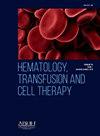小儿自身免疫性溶血性贫血:单中心回顾性研究
IF 1.8
Q3 HEMATOLOGY
引用次数: 0
摘要
背景:自身免疫性溶血性贫血(AIHA)是一种罕见的、危及生命的儿科疾病。本文描述了自身免疫性溶血性贫血患者的临床特征、诊断工作、治疗和结果:方法:回顾性分析巴西一家三级医疗机构在 2006 年至 2021 年期间收治的 18 岁以下 AIHA 患者的病历。数据分析以描述性为主,采用中位数、四分位数间距,分类变量以绝对频率表示:本研究共评估了 24 名患者(14 名女性,10 名男性)。诊断时的中位年龄为 5.99 岁(范围:0.25-17.1 岁),中位血红蛋白水平为 4.85 g/dL(范围:4.17-5.57 g/dL)。大多数患者有温性抗体(83.3%)。12名患者(50%)患有已知的基础疾病,4名患者(16.6%)在出现AIHA的同时还伴有急性传染病,3名患者(12.5%)与疫苗接种后的关联尚不确定。在 23 例患者中,类固醇和静脉注射免疫球蛋白是一线疗法。7名患者(29.1%)需要接受二线和三线治疗(利妥昔单抗、环磷酰胺和脾切除术)。中位随访时间为 4.4 年(范围:1.0-6.7 年)。13名患者(54.1%)出院,5名患者(20.8%)失去随访,没有患者死亡。其余6名患者的中位年龄为11.53岁(8.5-14.7岁),所有患者均已完全康复,无需进一步治疗:结论:大多数 AIHA 病例继发于潜在的全身性疾病,或可能与感染/疫苗有关,并对类固醇类药物有反应。难治和复发病例的二线和三线疗法仍是一个难题。一项前瞻性多中心研究对于确定最佳治疗组合至关重要。本文章由计算机程序翻译,如有差异,请以英文原文为准。
Pediatric autoimmune hemolytic anemia: A single-center retrospective study
Background
Autoimmune hemolytic anemia (AIHA) is a rare, life-threatening disease in pediatrics. This article describes the clinical features, diagnostic workup, treatment and outcome in patients with AIHA.
Method
Medical charts of under 18-year-old patients with AIHA treated at a tertiary Brazilian institution from 2006 to 2021 were retrospectively reviewed. Data analysis was primarily descriptive, using medians, interquartile ranges, and categorical variables presented as absolute frequencies.
Main results
Twenty-four patients (14 female, 10 male) were evaluated in this study. The median age at diagnosis was 5.99 years (range: 0.25–17.1 years) and the median hemoglobin level was 4.85 g/dL (range: 4.17–5.57 g/dL). Most had warm antibodies (83.3 %). Twelve patients (50 %) had known underlining diseases, four (16.6 %) presented with AIHA concomitant with acute infectious diseases and three (12.5 %) had an undetermined post-vaccine association. Steroids and intravenous immunoglobulin were first-line therapy in 23 cases. Seven patients (29.1 %) required second and third-line treatments (rituximab, cyclophosphamide and splenectomy). The median follow-up period was 4.4 years (range: 1.0–6.7 years). Thirteen patients (54.1 %) were discharged, five cases (20.8 %) were lost to follow-up and no patient died. The median age for the six remaining patients was 11.53 years (8.5–14.7) with all of them having complete responses with no further therapies.
Conclusion
Most cases of AIHA are secondary to an underlying systemic disease or have a possible correlation with infections/vaccines and respond to steroids. The second and third-line therapies for refractory and relapse cases remain a dilemma. A prospective, multicenter study is essential to address the best therapeutic combinations.
求助全文
通过发布文献求助,成功后即可免费获取论文全文。
去求助
来源期刊

Hematology, Transfusion and Cell Therapy
Multiple-
CiteScore
2.40
自引率
4.80%
发文量
1419
审稿时长
30 weeks
 求助内容:
求助内容: 应助结果提醒方式:
应助结果提醒方式:


